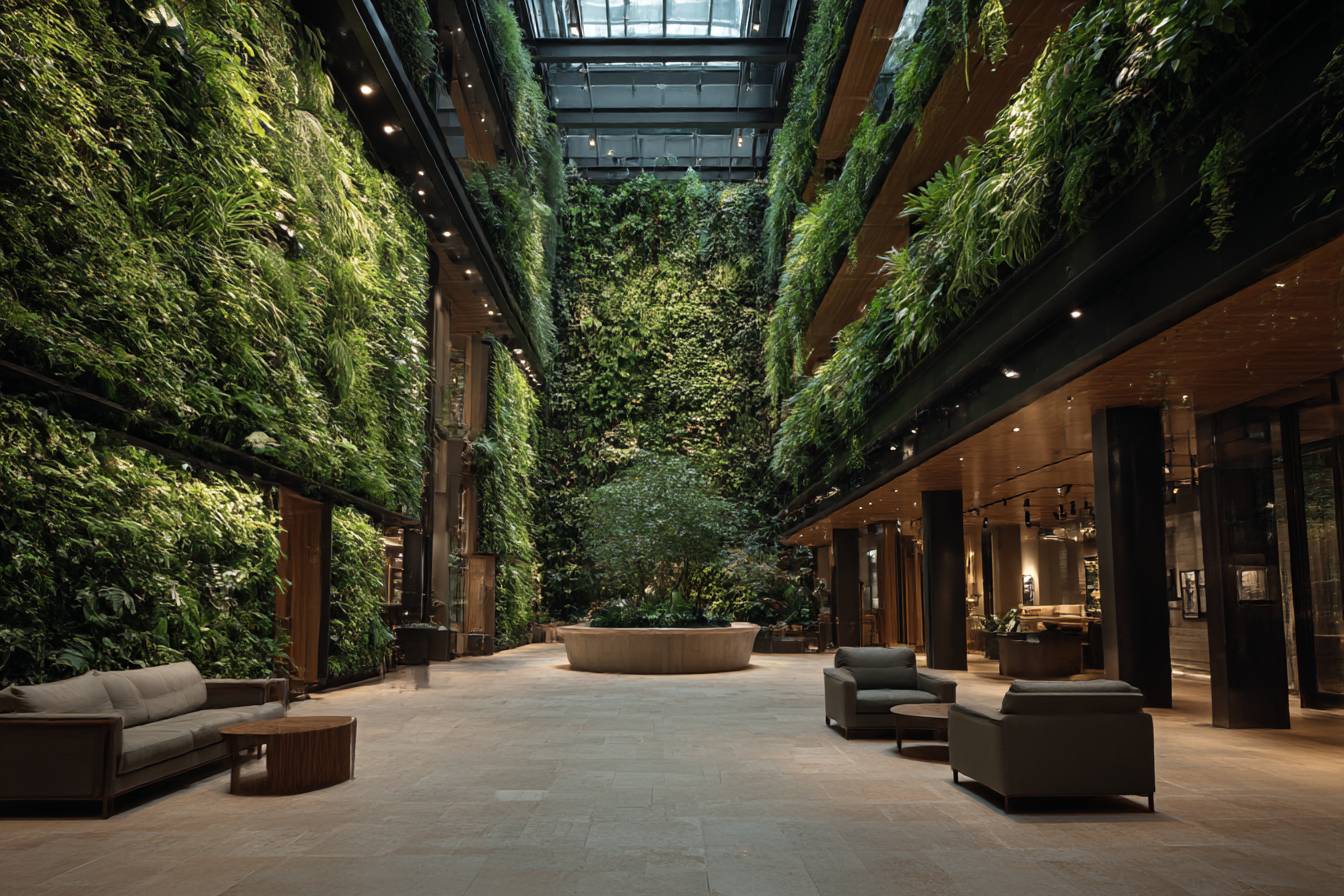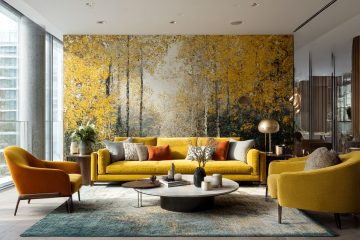So here’s the thing – I used to think “biophilic design” was just fancy Instagram speak for “having a lot of plants.” Like, cool, you’ve got money for fiddle leaf figs and floor-to-ceiling windows, good for you. Then I spent a year locked in my 400-square-foot studio during the pandemic, slowly losing my mind, and accidentally discovered what this whole concept actually means.
I stumbled into it completely by accident. After buying Patricia (my first pothos) out of desperation, then gradually turning my tiny apartment into what looked like a very amateur greenhouse, I started falling down Reddit rabbit holes about why plants made me feel less terrible. That’s when I learned about biophilia – literally “love of living things” – and realized there was actual science behind why staring at Patricia’s new leaves made me happier than scrolling through Twitter.
What is biophilic design really about?
Turns out it’s not just about plants at all. Biophilic design is basically about reconnecting with nature through our built environments, and it’s based on this idea that humans evolved in natural settings for millions of years. We’re hardwired to respond to natural elements – light patterns, textures, sounds, airflow – even when we’re stuck in concrete boxes that were clearly designed by people who forgot humans are animals too.
The research behind this is actually pretty wild. I went down a whole rabbit hole reading about Terrapin Bright Green’s research on biophilic design patterns after I noticed how much better I felt once I’d made some changes to my apartment. They identified seven core patterns that consistently improve wellbeing and performance:
The 7 Core Biophilic Design Patterns:
- Direct visual connection to nature (windows, courtyards)
- Natural materials with visible grain and texture
- Dynamic natural light and airflow patterns
- Water features for sound masking and humidity
- Natural shapes and forms (fractals, curves)
- Seasonal and temporal changes
- Refuge spaces that feel safe and enclosed
Looking at this list in my dim studio apartment was… depressing. Visual connection to nature? I can see a brick wall three feet away. Dynamic natural light? I get about forty-five minutes of indirect sunlight on a good day. Water features? I can barely afford groceries, let alone a fountain.
But here’s what I learned through a lot of trial and error: you can work with biophilic principles even in the worst possible conditions. It just requires creativity and accepting that your space won’t look like those plant influencer accounts with perfect lighting and unlimited budgets.
Take natural light – the thing my apartment has approximately zero of. I couldn’t add windows, but I could get grow lights that actually mimicked natural light spectrums instead of those harsh overhead fluorescents that make everything feel like a medical facility. I found some full-spectrum LED lights on Amazon that weren’t too expensive and set up a lighting system that changes throughout the day. Not the same as actual sunlight, but it helped regulate my sleep and made the space feel less cave-like.
The research on natural light is pretty convincing – it helps regulate circadian rhythms, improves sleep, and increases alertness. Hospital patients recover faster with nature views from their rooms. Students perform better on tests in naturally lit classrooms. Office workers take fewer sick days when they have access to daylight. These aren’t small effects either – some studies show 15-25% improvements in cognitive performance and stress reduction.
Water features seemed completely out of reach until I found a small tabletop fountain at a thrift store for twelve dollars. It’s nothing fancy – just a little ceramic thing with a tiny pump – but it masks the noise from my upstairs neighbors and adds humidity to the dry winter air. I was skeptical about spending money I didn’t have on something that seemed purely aesthetic, but it genuinely made a difference in how the space felt.
Simple Changes That Actually Work
Natural materials were another game-changer that didn’t require major expense. I started hitting up estate sales and Facebook Marketplace for solid wood furniture instead of the particleboard stuff I’d been buying new. Found a small wooden desk for thirty dollars that replaced my plastic folding table. Got some woven baskets for storage instead of plastic bins. These weren’t huge changes, but having materials with natural textures and patterns made everything feel warmer and more connected to something real.
Here’s where a lot of people get biophilic design wrong – they think you just add some houseplants and call it good. Plants are great (obviously, look at my Instagram), but real biophilic design goes deeper. It’s about creating visual complexity that our brains evolved to process. It’s about incorporating natural light patterns and airflow. It’s about understanding that humans aren’t separate from nature – we ARE nature, even when we’re living in poorly designed urban housing.
During the worst part of the pandemic, when I was working from my kitchen table and sleeping six feet away from my “office,” I started experimenting with what I now think of as emergency biophilic design. I couldn’t change the basic structure of the space, but I could work with lighting, natural materials, and strategic plant placement to create different zones and improve how the air felt.
The transformation wasn’t immediate – took a few weeks to notice the effects. But I started sleeping better, focusing more easily during work, and actually wanting to spend time in my apartment instead of constantly looking for excuses to leave. Friends started commenting that the space felt more welcoming, staying longer when they visited.
Simple Biophilic Changes Anyone Can Make (Even on a Budget):
- Position your desk or workspace near whatever natural light you have
- Use mirrors strategically to reflect outdoor views deeper into rooms
- Add a small water fountain to mask noise and increase humidity
- Choose solid wood furniture over laminate when possible (check thrift stores)
- Open blinds during the day instead of relying entirely on artificial lighting
- Select plants based on your actual lighting conditions, not what looks good on Instagram
The research backing this up is pretty compelling. Studies show hospital patients with nature views recover 30% faster. Students in classrooms with plants score 10-14% higher on tests. Office workers report 38% less fatigue in spaces with natural elements. Retail customers spend 11% more in stores with skylights. These aren’t small effects – we’re talking about measurable improvements in health and performance just from incorporating natural elements into built environments.
What This Means for Small Space Living
Living in a tiny apartment taught me that biophilic design isn’t about having the perfect space with floor-to-ceiling windows and unlimited budgets. It’s about understanding what humans need to feel good and finding creative ways to meet those needs within whatever constraints you’re dealing with.
I’ve connected with other people through my blog who’ve made dramatic improvements for under $100. One reader rearranged her home office setup to maximize the morning light she gets through her one decent window – her sleep schedule improved within two weeks. Another person added a small fountain and some carefully chosen plants to their studio apartment and found they stopped feeling constantly anxious about being home.
What’s frustrating is realizing how many affordable housing options completely ignore basic human needs for natural light, outdoor access, and connection to nature. It’s not an accident that luxury apartments have better windows, outdoor spaces, and natural materials while affordable housing often feels like it was designed to make people miserable. Access to biophilic design elements shouldn’t be a luxury, but in practice, it mostly is.
Looking ahead, I think biophilic principles will become more standard as research continues connecting nature exposure to immune function and cognitive performance. The question won’t be whether to include natural elements – it’ll be how to do it most effectively, especially in dense urban environments where most young people can actually afford to live.
For now, start paying attention to how different environments make you feel. Notice when you walk into a space and immediately relax or feel energized. Notice when harsh lighting makes you tired or when natural textures make a room feel more welcoming. That awareness is the foundation – once you recognize these patterns, you can make intentional choices about creating spaces that support your wellbeing, even in a tiny apartment with terrible lighting and a view of a brick wall.
Robert is a retired engineer in Michigan who’s spent the past few years adapting his longtime home for accessibility and wellbeing. He writes about practical, DIY ways to make homes more comfortable and life-affirming as we age — from raised-bed gardens to better natural light.




